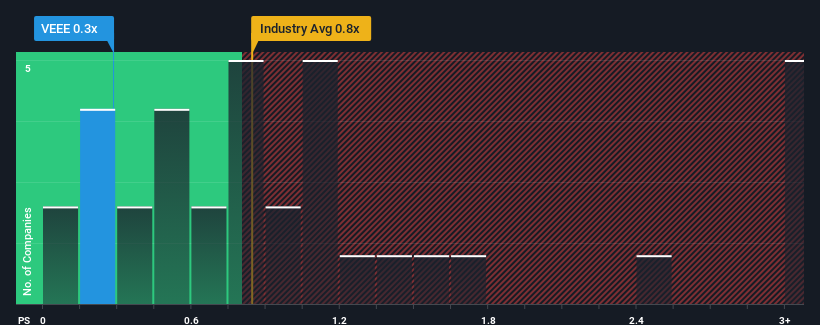- United States
- /
- Leisure
- /
- NasdaqCM:VEEE
Twin Vee Powercats Co.'s (NASDAQ:VEEE) 29% Dip In Price Shows Sentiment Is Matching Revenues
Unfortunately for some shareholders, the Twin Vee Powercats Co. (NASDAQ:VEEE) share price has dived 29% in the last thirty days, prolonging recent pain. For any long-term shareholders, the last month ends a year to forget by locking in a 72% share price decline.
After such a large drop in price, it would be understandable if you think Twin Vee Powercats is a stock with good investment prospects with a price-to-sales ratios (or "P/S") of 0.3x, considering almost half the companies in the United States' Leisure industry have P/S ratios above 0.8x. Although, it's not wise to just take the P/S at face value as there may be an explanation why it's limited.
See our latest analysis for Twin Vee Powercats

How Twin Vee Powercats Has Been Performing
For instance, Twin Vee Powercats' receding revenue in recent times would have to be some food for thought. It might be that many expect the disappointing revenue performance to continue or accelerate, which has repressed the P/S. If you like the company, you'd be hoping this isn't the case so that you could potentially pick up some stock while it's out of favour.
Want the full picture on earnings, revenue and cash flow for the company? Then our free report on Twin Vee Powercats will help you shine a light on its historical performance.How Is Twin Vee Powercats' Revenue Growth Trending?
Twin Vee Powercats' P/S ratio would be typical for a company that's only expected to deliver limited growth, and importantly, perform worse than the industry.
Retrospectively, the last year delivered a frustrating 57% decrease to the company's top line. The last three years don't look nice either as the company has shrunk revenue by 8.8% in aggregate. Therefore, it's fair to say the revenue growth recently has been undesirable for the company.
In contrast to the company, the rest of the industry is expected to grow by 1.8% over the next year, which really puts the company's recent medium-term revenue decline into perspective.
With this information, we are not surprised that Twin Vee Powercats is trading at a P/S lower than the industry. However, we think shrinking revenues are unlikely to lead to a stable P/S over the longer term, which could set up shareholders for future disappointment. There's potential for the P/S to fall to even lower levels if the company doesn't improve its top-line growth.
The Final Word
Twin Vee Powercats' P/S has taken a dip along with its share price. Typically, we'd caution against reading too much into price-to-sales ratios when settling on investment decisions, though it can reveal plenty about what other market participants think about the company.
Our examination of Twin Vee Powercats confirms that the company's shrinking revenue over the past medium-term is a key factor in its low price-to-sales ratio, given the industry is projected to grow. At this stage investors feel the potential for an improvement in revenue isn't great enough to justify a higher P/S ratio. If recent medium-term revenue trends continue, it's hard to see the share price moving strongly in either direction in the near future under these circumstances.
Plus, you should also learn about these 5 warning signs we've spotted with Twin Vee Powercats .
If strong companies turning a profit tickle your fancy, then you'll want to check out this free list of interesting companies that trade on a low P/E (but have proven they can grow earnings).
Valuation is complex, but we're here to simplify it.
Discover if Twin Vee Powercats might be undervalued or overvalued with our detailed analysis, featuring fair value estimates, potential risks, dividends, insider trades, and its financial condition.
Access Free AnalysisHave feedback on this article? Concerned about the content? Get in touch with us directly. Alternatively, email editorial-team (at) simplywallst.com.
This article by Simply Wall St is general in nature. We provide commentary based on historical data and analyst forecasts only using an unbiased methodology and our articles are not intended to be financial advice. It does not constitute a recommendation to buy or sell any stock, and does not take account of your objectives, or your financial situation. We aim to bring you long-term focused analysis driven by fundamental data. Note that our analysis may not factor in the latest price-sensitive company announcements or qualitative material. Simply Wall St has no position in any stocks mentioned.
About NasdaqCM:VEEE
Twin Vee Powercats
Designs, manufactures, and markets recreational and commercial power boats.
Moderate risk with adequate balance sheet.
Market Insights
Community Narratives



